
This page contains headlines from before
December 2006. See the main page for more
recent news.
![[Duke University Primate Center]](dupcban3.gif)

- As
presidential election approaches, Madagascar's lemur sanctuary burns
- Mongabay
- 23 Nov 2006: "Forest fires are burning crucial
lemur habitat and other hotbeds of biodiversity in Madagascar
according to reports from the northeastern part of the
island."
- Madagascar's
Mouse Lemurs: Three New Species of World's Smallest Primate
- Der Spiegel
- 22 Nov 2006: "Working together with colleagues
in Madagascar, scientists at the Institute for Zoology at the
University of Veterinary Medicine (TiHo) in Hanover, Germany
discovered and classified the animals." Also reported by Mongabay
and Nature.
- Different
coat color may not mean different species for lemurs - Eurekalert
- 15 Nov 2006: "Surprisingly, the researchers found
that although the lemurs appeared to be different
species because they were visually distinct, they did not
differ genetically." Also reported by New
Scientist.

- Lemur
conservation requires poverty alleviation initiatives in
Madagascar - Mongabay
- 5 Nov 2006: "Charlie Welch, currently a
research scientist at the Duke University Lemur Center,
recently answered some questions on his experiences in lemur
conservation. Welch, along with his wife Andrea Katz, has
worked in Madagascar for 17 years and helped transform
conservation efforts in the country."
- Madagascar
is ecotourism heaven: Beautifully bizarre, but isolated island's
habitats face a fight for survival - Miami Herald
- 24 Sep 2006: "Madagascar, the world's fourth
largest island, is home to some of the most beautifully
bizarre animals and plants on Earth that evolved during 160
million years of isolation in the Indian Ocean."
- Leaping
lemurs: Come for the stink fights, stay for a song - Miami Herald
- 24 Sep 2006: "In ringtail troops, squabbles
sometimes end in stink fights. Lemurs rub their tails against
the scent glands on their arms and armpits and then wave their
tails in the direction of their opponents."
- Climate
Change Threatens Lemurs - Mongabay
- 19 Sep 2006: "Tropical rainforests are among the
most stable environments on Earth, but they are still no
match for global climate change. Dr. Patricia Wright, the
widely admired primatologist and Professor of Anthropology at
Stony Brook University, finds that climate change could mean
the difference between survival and extinction for endangered
lemurs." Also reported by The
Independent.
- Literally,
flying lemurs (and not dermopterans) - Tetrapod Zoology
- 8 Sep 2006: "You might be surprised to learn
that there is an extensive literature discussing the apparent
gliding behaviour of lemurs and other primates, much of it
reviewed in Demes et al.'s 1991 paper 'They seem to
glide'."
- Interview
with Dr. Anne Yoder
![[Audio]](audio.png) - WCOM-FM
- WCOM-FM
- 30 Aug 2006: Radio In
Vivo interviews Dr. Anne Yoder, Director of the Duke
Lemur Center. [MP3 format, 24 MB, run time 1 hr.]
- Viv
is off to Madagascar - Matlock Today
- 30 Aug 2006: "Vivyan Lisewski will be arriving
on the island on October 5, to take part in a ten week
charity project."
- Zoological
garden welcomes newborns - news.gov.hk
- 28 Aug 2006: "Six endangered primates - one
white-faced saki, three ring-tailed lemurs and two black and
white ruffed lemurs - have recently been born at the [Hong
Kong] Zoological & Botanical Gardens."
- Madagascar
is weird and wonderful - Independent Online
- 14 Aug 2006: "We hiked through dense, untouched
rainforest in search of the diademed sifaka and the
black-and-white ruffed lemurs that inhabit this park. Along
the way, we spotted a large family of tenerics (minute
hedgehog-like creatures), exotic birds of all varieties and
an astounding array of plants and trees, most of them endemic
to Madagascar."
- Apes,
not Monkeys, Ace IQ Tests - DukeMedNews
- 1 Aug 2006: "The great apes are the smartest
of all nonhuman primates, with orangutans and chimpanzees
consistently besting monkeys and lemurs on a variety of
intelligence tests, Duke University Medical Center
researchers have found." Also reported by Mongabay
and the CBC.
- Rare
indri lemur born in forest reserve in Madagascar - Mongabay
- 13 Jul 2006: "The birth occurred at Palmarium,
a small private reserve of lowland tropical forest
established by a tour operator in Madagascar. It is the
second birth of an Indri since the opening of the park,
according to Fabiola Deprez at Boogie Pilgrim, a tour
operator based in the capital Antananarivo."
- Slender
Loris gasps for survival as urban India expands
- Lanka Business Online
- 27 Jun 2006: "But the biggest threat to the
rare nocturnal animal, which has a distinctive a big head,
wide brown eyes and is so small it can be held in your hand,
is the recent encroachment of human activity on to patches of
forest in southern India and Sri Lanka that the primate calls
home."
- Exotic
Animals Found in Tanzanian Mountains - LiveScience
- 23 Jun 2006: "Other endemic species spotted in
the Eastern Arc include two chameleons, a Zanzibar bush baby,
the checkered elephant shrew (Rhynchocyon cirnei), and
several birds."
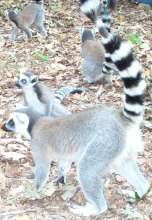
- Primatologists
aim to ape bird watchers - Reuters AlertNet
- 23 Jun 2006: "'Bird watching is a multi-billion
industry and enthusiasts are always ticking new species they
see. But no one is doing this for primates,' said
primatologist Russ Mittermeier, president of NGO Conservation
International."
- Malagasy
ecoguides hold key to the forest - Reuters AlertNet
- 23 Jun 2006: "Spotting concealed wildlife in
Madagascar's rainforest is a rare skill that 50-year-old
Rabarison has honed through a childhood spent playing in the
bush and an adulthood spent as an eco-guide."
- Three
new lemurs take a bow in Madagascar - Reuters AlertNet
- 21 Jun 2006: "The three new mouse lemurs were
officially named in a paper published in June by the
International Journal of Primatology and announced at a
conservation conference on Wednesday in the Malagasy
capital." Also reported by Conservation
International and Omaha's
Henry Doorly Zoo.
- Madagascar's
Perfumed Isle - MSNBC
- 20 Jun 2006: "Almost 80 percent of Madagascar's
fauna exists only within the water-bound borders of this
island nation. Madagascar has been separated from the
mainland of Africa for several millennia, and in the splendid
isolation of an island world Mother Nature went crazy with
the wildlife."
- Africa
looks to cash in on environment - CNN/AP
- 20 Jun 2006: "Touting itself as a destination
of unmatched natural wonder, Madagascar is protecting its
remaining environmental riches in hopes of gaining long-term
benefit for its people."
- Conference
to Address Mysteries of Madagascar's Rich but Threatened Biodiversity
- Duke University News Service
- 13 Jun 2006: "An international group of some
three dozen experts will meet here at the National
Evolutionary Synthesis Center June 14-16 to develop research
and conservation strategies for Madagascar, a Texas-sized
island off the coast of Africa with a puzzlingly rich
history of biodiversity and significant contemporary
environmental problems."
- African
countries brand themselves with eco-labels - ABC News
- 11 Jun 2006: "'If you look at Madagascar, its
nature is its only competitive advantage. It's diverse and
unique. There is no other place to go to see lemurs,' said
Olivier Langrand, vice-president of U.S.-based Conservation
International."
- Black
and white ruffed lemurs born at zoo - Woodland (Ca.) Daily Democrat
- 8 Jun 2006: "The Sacramento Zoo is pleased to
announce its newest arrivals - one female and two male black
and white ruffed lemurs - born to parents, both of which are
7 years old."
- Scientists
develop first comprehensive theory explaining Madagascar's rich
biodiversity - EurekAlert
- 18 May 2006: "An international team of
scientists has developed an explanation for why Madagascar
has such a wealth of animals found only on this island."
- Do
you love lemurs? - BBC
- 12 May 2006: "A love of lemurs and a passion
for presenting are all that are required to assist in the
walk-through lemur section of the [Bristol, UK] zoo's brand
new monkey enclosure that opens in June."
- 'Banana-Jawed'
Fossil Mammal Linked to Rare Sound-Producing Skill
- Duke University News Service
- 26 Apr 2006: "Further, the team speculated, the
animals may have used the balloonlike structural chamber
that shaped their bizarre jaws to produce sound.
If this speculation is correct, Thyrohyrax and its
fossil relatives would be the only mammals found so far to
use such a skeletal structure for producing sound, the
researchers said."
- The
Duke Lemur Center: New Name, New Goals
- Duke University News Service
- 25 Apr 2006: "'Our new name, the Duke
Lemur Center, reflects a refocusing of our scientific
goals and overall mission,' said Anne D. Yoder, the center's
director since Jan. 1." Also reported by the Durham
Herald-Sun.
- For
the Love of Lemurs - Smithsonian Magazine
- April 2006: "[Patricia] Wright, a late-blooming
primatologist from the State University of New York at Stony
Brook, has made lemurs her life, tracking bamboo lemurs and
sifaka lemurs that live in a handful of social groups in
Ranomafana National Park."
- Madagascar
Expands Protected Areas Under Visionary Conservation Policy
- Conservation International
- 22 Mar 2006: "A pioneering government plan to
protect much of Madagascar's remaining forests has expanded
by another 1 million hectares (2.47 million acres or 3,862
square miles), providing new hope that highly threatened
species such as black-and-white ruffed lemurs, golden-crowned
sifakas and Madagascar serpent-eagles can avoid extinction."
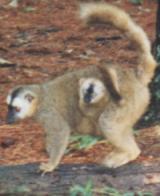
- Of
Lemurs and Leeches - San Francisco Chronicle
- 19 Mar 2006: "I was in Madagascar with a group
of Earthwatchers who had volunteered to help primatologist
Patricia Wright collect field data for a study of
Propithecus diadema edwardsi at Ranomafana National
Park. Perhaps you know Propithecus by its common name,
the Milne-Edwards' sifaka."
- Wild
Animals of Xeko Mission: Madagascar Set to Invade The Q on Kids Day
at Cavs vs. Lakers Game This Sunday
- National Basketball Association
- 16 Mar 2006: "Move over Pokeman and Yu-gi-oh....
There's a new adventure that is going to 'take over the
island' in collectible trading card popularity, Xeko Mission:
Madagascar (pronounced 'Zeeko')."
- Madagascar
coming to Chahinkapa Zoo - Wahpeton Daily News
- 16 Mar 2006: "Some new animals are in route to
Chahinkapa Zoo at Wahpeton [North Dakota]. The zoo is
acquiring two reindeer, two fossa and five new lemurs. Kathy
Diekman, zoo director, said with the fossa and lemurs zoo
staff will do a Madagascar and predator-prey theme."
- Gladys
Porter Zoo researcher tracks wild lemurs in Africa
- Brownsville Herald
- 5 Mar 2006: "Before her African adventure,
[Jennifer] Chatfield, senior veterinarian at the Gladys
Porter Zoo, grew up in the 4-J Conservation Center outside
San Marcos, a home for rare and endangered species and, more
specifically, a haven for furry little primates called
lemurs."
- Three
new species of lemurs identified - EurekAlert
- 22 Feb 2006: "Researchers have identified
three new species of lemurs, the small, big-eyed primates
native to the island of Madagascar. In a study
published today in the open access journal BMC
Evolutionary Biology, a team of researchers from
Madagascar and Europe identified new species of lemurs based
on differences in a specific gene sequence."
- New
'Lemurs of Madagascar' book released - EurekAlert
- 6 Feb 2006: "Written by a team including [Conservation
International] President Russell A. Mittermeier
and Malagasy primatologists Jonah Ratsimbazafy and Rodin
Rasoloarison, the book updates a first edition published in
1994 with subsequent research and genetic studies on lemurs
that identified 10 new species and reclassified nine others
as separate species."
- Angelique
the Aye Aye, a Primate Center Triumph
- Duke University News Service
- 26 Jan 2006: "At only a couple of pounds, the
gangly creature named Angelique hardly seems like the
centerpiece of an historic event in the preservation of her
highly endangered species. But the little aye aye is, indeed,
just that. She is the first of her species ever born to
parents who were themselves born in captivity."
- Madagascar
seeks investment into ecotourism - Reuters AlertNet
- 24 Jan 2006: "Madagascar wants foreign investors
to set up hotels and tourist facilities in its wildlife
reserves to boost revenue for cash-starved conservation
schemes, the island's parks director said on Tuesday."
- Researcher
hears a cry for help from rare silky sifakas - Seattle Times
- 20 Jan 2006: "It is after 2 p.m. and the dense,
hilly rain forest has yet to give primatologist Erik Patel a
glimpse of Propithecus candidus, the rare lemur known
as the silky sifaka." Also reported by the Boston
Globe.
- A
glimpse behind the vanilla curtain - Financial Times
- 14 Jan 2006: "Verreaux's Sifaka, the species
of lemur that the people of southern Madagascar's Androy
region call 'the dancer', has whitish fur and a black face.
It looks a bit like a vervet monkey or a Siamese cat, albeit
one with the ability to walk on its hind legs."
- 1
million ha now protected in Madagascar, island home of lemurs
- Mongabay
- 6 Jan 2006: "The government of Madagascar has
scored a significant victory for conservation by bringing one
million hectares (more than 3,800 square miles) of wild
landscapes and seascapes under protection to conserve the
island nation's unique fauna and flora, according to the Wildlife
Conservation Society (WCS)." Also reported by EurekAlert.
- A
world apart - Bangkok Post
- 22 Dec 2005: "Walking through the jungle, we
spotted a lemur napping on a tree. Indri Indri, the biggest
of the lemur species, was the size of a human child. It had a
stumpy tail and was hugging a trunk enjoying a mid-day rest."
- Extinction
alert for 800 species - BBC
- 12 Dec 2005: "Researchers have compiled a global
map of sites where animals and plants face imminent
extinction. The list, drawn up by a coalition of
conservation groups, covers almost 800 species which they
say will disappear soon unless urgent measures are taken."
Also reported by USA
Today.

- Furry
mascot of RP forest lives on borrowed time - Philippine Explorer
- 19 Nov 2005: "Hunting and trading in Tarsius
syrichta, the species found in the Philippines, was banned
in the mid-1990s, when Pizarras flew to Manila with two
orphaned tarsier babies to meet Prince Charles, who was in the
country, and enlisted the heir to the British throne's support
to help save the species."
- Duke
Primate Center welcomes Angelique - Durham Herald-Sun
- 14 Nov 2005: "At least that's been the experience
at the Duke Primate Center, where diligent matchmakers have
been rewarded with the first known aye-aye born in captivity
to parents that also had been born in captivity." Also
reported by the Raleigh
News & Observer.
- Swiss
name lemur after master of silly walks - swissinfo
- 11 Nov 2005: "Two Zurich University researchers
have discovered a new species of lemur, and named it after
Monty Python star John Cleese." Also reported by ABC
News and USA
Today.
- Did
Humans Eat Giant Lemur to Extinction? - Discovery Channel
- 1 Nov 2005: "The first humans that settled
Madagascar around 2,000 years ago likely hunted to extinction
giant lemurs and other unusual animals from the Indian Ocean
island, such as eleven-foot-tall birds, suggests an upcoming
study."
- Teeth,
rainfall linked to primate survival - UPI
- 31 Oct 2005: "To discover how tooth wear might
influence reproduction, Jernvall, Wright and colleagues
documented tooth wear in a population of Madagascar rainforest
lemurs, called sifakas, during the past 20 years." Also
reported by National
Geographic News.
- Falling
from the tree - The Guardian
- 22 Oct 2005: "Lemurs, the long-tailed,
tree-living creatures that share ancestors with man, are
fighting for survival in Madagascar - which, apart from the
neighbouring Comoros islands, is their only habitat in the
world."
- New
Primate Fossils Support "Out of Africa" Theory - National
Geographic News
- 17 Oct 2005: "Researchers have discovered
fossilized remains of two previously unknown primate species
that lived 37 million years ago in what is now the Egyptian
desert."
- Yoder
to reinvigorate, expand DUPC - The Chronicle
- 13 Oct 2005: "Anne Yoder has high hopes for
the futures of prosimian primates, large and small, housed
at the Duke University Primate Center."
- Myakka
lemur reserve plans research facility - Bradenton Herald
- 27 Sep 2005: "The Lemur Conservation Foundation,
which occupies 90 acres in Myakka City [Florida], has launched
a $3 million fundraising drive to assist with plans for a new
Center for Lemur Studies."
- More
than a zoo - Durham Herald-Sun
- 25 Sep 2005: "Among the animal kingdom's most
spellbinding sights is a troupe of lemurs in the wilds of
Madagascar, bounding together from tree to tree so nimbly
that they seem to fly in formation." Also reported by the Raleigh
News & Observer.
- A
fragment of Africa set adrift in the ocean - The Observer
- 25 Sep 2005: "'Welcome to Anjajavy International
Airport' reads the sign on a mahogany 'arrivals lounge' no
bigger than a poolside cocktail bar - the first of several
ironic indicators that this luxurious, fly-in resort is as
far from mass tourism as it gets."
- Two
new lemur species discovered - Eurekalert
- 9 Aug 2005: "Finding a new species of lemur is
rare; this discovery brings the number of known lemur species
from 47 to 49. . . The new lemurs were discovered by
scientists at the German Primate Center (DPZ) and the
University of Göttingen and are described in the current
issue of the journal Primate Report." Also
reported by the BBC.
- Madagascar's
unique forest under threat - The Observer
- 7 Aug 2005: "Up to 1,000 hectares of land and
coastal rainforest bordering the Indian Ocean will be dug up
in different phases of the £430 million project to
extract ilmenite, a mineral which can be used to produce
titanium dioxide pigment."
- Safe
haven for rare lemurs - in Bolton - Manchester Evening News
- 24 Jun 2005: "Terry [Pearson] has been breeding
lemurs, a group of primates which occur naturally only in
Madagascar and neighbouring Indian Ocean islands, for 16
years."
- Madagascan
police intercept illegally logged wood - Reuters
- 1 Jun 2005: "Madagascan police have intercepted
a shipment of more than 500 tonnes of hardwood cut from
protected rainforests sheltering some of the world's most
treasured wildlife, a government minister said Wednesday."
- Ancient
DNA Confirms Single Origin of Malagasy Primates
- Yale University
- 27 May 2005: "Yale biologists have managed to
extract and analyze DNA from giant, extinct lemurs, according
to a Yale study published in a recent issue of the Proceedings
of the National Academy of Sciences."
- Ya
Gotta Love Lemurs - San Francisco Chronicle
- 22 May 2005: "'In terms of popularity with
visitors, lemurs are in the top 10,' says Nancy Chan, public
relations director for the San Francisco Zoo, counting the
personable primates among your standard lions, gorillas and
bears."
- Environmentalists
hope a new film will help lemurs
- Pittsburgh Post-Gazette
- 6 May 2005: "At the end of this month,
DreamWorks Animation SKG Inc. will release a new movie called
'Madagascar,' and Conservation International, an aggressive,
well-connected American environmental group, wants to make
sure the country doesn't let the free Hollywood publicity slip
through its opposable thumb and forefinger."
- In
Search of the Aye-aye - Mongabay
- 17 Apr 2005: "In late October 2004, I traveled
to Nosy Mangabe, which is one of the best places to see wild
aye-aye today. The island, forested with tropical rainforest
and having a rich history involving 17th century pirates,
lies close enough to the town of Maroantsetra for a day
trip, though an night-time stay is crucial if you hope to
see the aye-aye."
- Rare
aye-aye born in Bristol zoo - ITV
- 15 Apr 2005: "Kintana, an eight-week-old
Madagascan aye-aye, is the first captive bred aye-aye in
the UK." Also reported by the BBC.
- Madagascar's
conservation conundrum - BBC
- 11 Apr 2005: "But Malagasy people are among
the poorest on earth, the economy desperately needs a
boost, and beneath the precious forests are minerals that
could make the country wealthy."
- Quarter
of primates face abyss - BBC
- 7 Apr 2005: "Of the four global regions
inhabited by primates, the worst hit is Madagascar, where
loss of habitat to traditional slash-and-burn agriculture
has left some lemur species, such as Perrier's sifaka,
stranded in tiny areas of the forest."
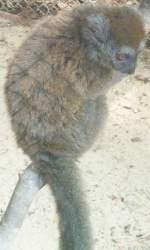
- Mitsubishi
Group Offsets Carbon Footprint Through Investment in Madagascar's
Rain Forest - Conservation International
- 25 Mar 2005: "This initiative will offset
Mitsubishi's carbon impacts by preventing the release of
carbon dioxide (CO2) into the atmosphere through
the protection of a portion of Makira's threatened forests -
which naturally store carbon - and by supporting sustainable
activities of local communities in the region."
- Duke
names director of Primate Center, home of lemurs
- Durham Herald-Sun
- 16 Mar 2005: "Duke on Wednesday named Anne
Yoder, a Yale professor who spent her early years in
Greensboro, as the next director of the center." Also
reported by Duke
University News Service, The
Chronicle, and Yale
Daily News.
- Male
sifaka born last month at zoo - Daily Democrat
- 10 Mar 2005: "The Sacramento Zoo is pleased to
announce its newest arrival - a male Coquerel's sifaka - born
to parents, both of which are 14 years old."
- Lemurs
Thrive in Preserve - The Ledger
- 6 Mar 2005: "And her research is not the only
activity at the Myakka City Lemur Preserve, which is quickly
growing from a grassroots nonprofit group to a premiere
conservation and research institution, scientists say."
- Florida
Reserve Aims to Save Endangered Lemurs - Voice of America
- 23 Feb 2005: "This isolated patch of Florida
forest is home to the Lemur Conservation Foundation, one of
the few lemur reserves in the world. The reserve opened three
years ago, and there are 30 lemurs here." Includes video.
- Renowned
conservationist's story began with a pet monkey - Newsday
- 18 Feb 2005: "The astonishing 37-year journey
of Patricia Wright from a self-described Brooklyn housewife
to a celebrated Stony Brook University anthropologist and
primate specialist has led her through the mysterious jungles
of three continents."
- Malagasy
wilderness in the balance - BBC
- 14 Feb 2005: "Madagascar is fast losing its
forest wilderness. But villagers are angered by moves to
prevent them cutting down trees in recently created nature
reserves."
- Tarsier
on 'borrowed time' due to lack of govt support - Manila Times
- 19 Jan 2005: "The Philippine Tarsier Foundation
Inc., organized by local businessmen in Bohol, an island of
1.2 million people, runs an 8.4-hectare forest reservation, a
sort of Noah's ark where Pizarras and two other forest
rangers live near about 100 tarsiers."
- Zoo
basks in discovery of two lemur species - Omaha World-Herald
- 11 Jan 2005: "The two newly confirmed species
are sportive lemurs living in different types of forest in
Madagascar. They are the first new species ever discovered
by the Omaha zoo." Also reported by National
Public Radio.
- Island's
wildlife refuge closing - Hinesville Coastal Courier
- 26 Dec 2004: "The [Wildlife Survival Center]
officials said it will continue conservation work, just not
on St. Catherines. Lattis said the needs that the center set
30 years ago have been met, adding that current objectives
allow the work on St. Catherines and other international
programs to be consolidated in the New York area at WSC
facilities, including the Bronx Zoo."
- Firefighters
Called as Lemur Chills Out in Tree - The Scotsman
- 25 Dec 2004: "Tayside Fire Brigade arrived at
the scene around 10am and, after some gentle prodding, the
small primate was found to be well -- and started dancing on
the branches to prove it."
- Madagascar's
poor see no benefit from conservation - Reuters
- 19 Dec 2004: "Since the government created the
reserve in 1990, Dimasy says life has been tough for the few
hundred villagers of Mahatsara which lies in depths of the
10,000-hectare (25,000-acre) Mantadia forest."
- Milestone
for 'land of the lemur' - BBC
- 11 Nov 2004: "It has been called the eighth
continent because of its unique wildlife which has evolved
in isolation for 165 million years. But Madagascar's
biodiversity - including 50 kinds of lemur - is under acute
threat from slash-and-burn agriculture in what is one of the
poorest countries on Earth."
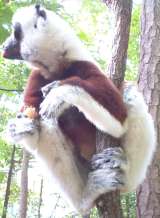
- Lemurs
rule the land at Manatee County reserve - Sarasota Herald-Tribune
- 8 Nov 2004: "Bud and Guinness are among 22
residents of Myakka City [Florida] Lemur Reserve, which
suffered through three hurricanes this summer under the
weary eyes of the reserve's three-human staff."
- Effort
to save Madagascar rainforest paying off - Boston Globe
- 7 Nov 2004: "Led by its president, the Indian
Ocean nation of Madagascar is racing to save an environment
as precious and fragile as any on earth. . .
Environmentalists say the decisive factor is whether a grand
bargain can be struck with communities such as those around
Andringitra: The residents will help protect natural areas
if they can benefit from it, largely through ecotourism."
- Zoo
update: Ruffed lemurs - Syracuse Post-Standard
- 12 Aug 2004: "The Rosamond Gifford Zoo at
Burnet Park is celebrating the 10th birthday of male black
and white ruffed lemurs, Kinte and Mouse, who were born Aug.
13, 1994."
- Biologist
Deciphering Complex Lemur Scent Language - Duke University
News Service
- 6 Aug 2004: "In fact, until Drea and Scordato
began their studies, scientists didn't even appreciate that
ringtails, and perhaps other lemurs, may well have the
richest scent language of any primates."
- Madagascar's
Trees May Be Tied to Lemurs' Fate - National Geographic News
- 26 Jul 2004: "On the island nation of
Madagascar off the southeast coast of Africa, only furry,
tree-dwelling primitive primates called lemurs are big enough
to move the seeds of many trees around and thus improve the
chances of the trees' survival."
- Lemur
Is First Known Hibernating Primate, Study Says
- National Geographic News
- 23 Jun 2004: "Yet researchers say a small,
nocturnal lemur resorts to the same tactic used by bears,
squirrels, and dormice to survive cold northern winters --
spending at least seven months of the year hibernating through
harsh times brought on by drought." Also reported by New
Scientist and Reuters.
- Madagascar
to honor Stony Brook anthropologist - Newsday
- 4 Jun 2004: "But for Stony Brook University
anthropologist and conservation biologist Patricia Wright,
it will be a welcome token of appreciation from a country
that has become her second home, and in which she has helped
a host of wildlife retain theirs."
- Experiments
Reveal Startling Insights Into Lemur Intelligence
- Duke University News Service
- 12 May 2004: "But at the Duke University
Primate Center, with the gentle touch of his nose to a
computer screen, the ringtail lemur called Aristides is
teaching psychologist Elizabeth Brannon a startling
scientific lesson -- that lemurs are, indeed, intelligent
creatures." Also reported by Reuters.
- Looking
for lemurs - USA Today
- 30 Mar 2004: "But I didn't -- and you don't --
have to travel half-way across the world to see these
creatures. The Duke University Primate Center in Durham,
N.C., is home to the largest and most diverse collection of
lemurs this side of the Atlantic Ocean."
- My
Reconciliation with Science - Duke Alumni Magazine
- Mar-Apr 2004: "By the time I got to Duke, I was
gunning for the Pulitzer, not the Nobel, and I certainly
didn't 'hope to study biology,' as I'd claimed. In fact, I
hoped never to take a lab class again. I might have managed
it, too, if it hadn't been for the Primate Center."
- Earthwatch
and Napier join fight to save habitat - The Scotsman
- 24 Jan 2004: Napier University and Earthwatch
are sponsoring a Malagasy conservationist to study in the
university's wildlife biology and conservation program.
- Ancestral
primate discovered - The Guardian
- 1 Jan 2004: "Xijun Ni of the Chinese Academy
of Science in Beijing and two colleagues report in
Nature today that they have unearthed the partial
skull and jaws of the most primitive specimen yet of the
mammalian line which gave rise to modern primates..."
- Zoo's Green
Team Dreams Up Unique Programs - KDLH-TV
- 29 Dec 2003: "Now you can grace your wall with
a work of art by the lemurs residing at the zoo."
- Lemur
exhibit to open in 2004 - Albany (Georgia) Herald
- 28 Nov 2003: "The four crowned lemurs in
quarantine at the Parks at Chehaw's Wild Animal Park will
be among 21 moving into a new Chehaw exhibit that is
expected to open in the spring." Also reported by AccessNorthGa.com.
- Primate
Center gets $4M - The Chronicle
- 24 Oct 2003: "The University renewed its
long-term commitment to the Primate Center, officials
announced Thursday, promising an investment of more than
$4 million to improve its infrastructure over the next
few years." Also reported by the Durham
Herald-Sun.
- Madagascar
to Triple Amount of Protected Space - Reuters
- 16 Sep 2003: "President Marc Ravalomanana
said his government would increase the amount of protected
area on the island to 15 million acres from 4.2 million."
- Diet
researcher asks how now lemur chow? - Duke University News Service
- 17 Jul 2003: "The larger pile of pounds of food
pellets, cabbage and bananas represented a human-sized
extrapolation of what the generous technicians had been
giving the lemurs -- the equivalent of a pile of Big Macs
and fries. And the smaller pile represented the human version
of a more reasonably sized diet. Since then, the technicians
have monitored more closely the portions they give the lemurs."
- Madagascar's
Lemurs Cling to Survival - ABC News/Reuters
- 16 Jul 2003: "The Analamazaotra Reserve, about
85 miles east of the capital Antananarivo, is one of the last
refuges of this teddy-bear-like creature [the indri] which
spends almost all its time high off the forest floor in trees."
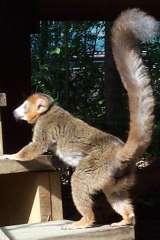
- Is
This the Smallest Primate on Earth? - National Geographic News
- 27 Jun 2003: "[Mireya Mayor is] also one of
a handful of scientists to perform critical work on the
highly endangered silky sifaka and Perrier's sifaka, whose
habits remain a mystery to biologists. Recently, Mayor and
fellow researcher Ed Louis discovered a new species of mouse
lemur that may be the smallest primate in the world."
- Top
lemur expert grew up here - Rochester Democrat and Chronicle
- 16 Jun 2003: "Today, Patricia C. Wright
tends to look up more than down, scanning the canopy of
the Madagascar rain forest. Her work on lemurs -- a
primitive primate virtually exclusive to that African
island -- draws the attention of scientists all over
the world."
- The
zoo's losers - San Francisco Bay Guardian
- 7 May 2003: "The new displays are as
lofty and grand as the rhetoric of zoo management, which
touts conservation-oriented goals in public statements
and on banners at the new Lipman Family Lemur Forest
exhibit. Yet despite promising to get the animals off
concrete and onto grass, during the 1997 bond campaign
aimed at funding a massive renovation, management has made
few significant changes to the animals' housing conditions."
- Fossil
teeth reveal oldest bushbabies, lorises - EurekAlert
- 26 Mar 2003: "The tiny fossils offer
evidence that the ancestors of bushbabies and lorises
appeared during the Eocene epoch that lasted from 55
million to 34 million years ago -- at least twice as
early as previous fossils had shown." A differing
interpretation of the find is also reported.
Original press releases: [1,
2]
- Conservationists
play part in lemurs' future - BBC
- 19 Mar 2003: "The work of Jersey's Durrell
Wildlife Trust has helped to ensure the natural habitat
of lemurs in Madagascar is protected."
- Mammals
'sailed to Madagascar' - BBC
- 13 Feb 2003: "All mammals on the island
of Madagascar are descended from four ancestral species
that sailed from Africa clinging to rafts of plant
material, scientists have said." Also reported by EurekAlert.
- Cuts
threaten to close Primate Center - The Chronicle
- 23 Jan 2003: "The announcement of
potential cutbacks to the faculty of the Biological
Anthropology and Anatomy department has heightened
anxiety about the future of the Primate Center.
Even though the Primate Center is a separate entity from
BAA, the proposed cutbacks to the department cast further
doubt on the likelihood that the Primate Center will
remain at the University." Also reported by the
Charlotte
Observer.
- Primates
found popping prenatal drug - New Scientist
- 22 Jan 2003: "A Madagascan lemur has been
revealed as the first animal known to self-medicate when
pregnant. Female sifaka eat plants rich in poisonous
tannins in the weeks before giving birth, researchers
have discovered."
- Teaching
Zoo's animals available for adoptions - Ventura County Star
- 22 Jan 2003: "On a recent sunny afternoon,
13 first-graders from Simi Valley gathered around a big
cage at the zoo complex, simultaneously sending up an
'ooohh!' when they spied for the first time their
adopted lemur."
- Mad
about Madagascar: mesmerized by a mini-continent
- Environmental News Network
- 15 Jan 2003: "Travelers accept
Madagascar's discomforts because the country houses some
of Earth's most unique wildlife. In the Spiny Desert, the
green tentacle-like branches of "octopus trees" soar 30
feet in the air, while in the mountains, a small insect
called the giraffe-necked weevil has a red body and a neck
like a cherry picker. But perhaps the strangest creature of
all is the Aye Aye, which seems like a fusion of monkey,
bat and woodpecker."
- [Duke
University] Primate Center initiates unique research
- The Chronicle
- 6 Nov 2002: "The Primate Center is
especially important because in many cases it houses
the only members of a particular species in captivity
in the entire world. Since July 2001, at least 42 new
research protocols have become active at the center."
- Third
of primates 'risk extinction' - BBC
- 7 Oct 2002: "One-third of the world's
primate species now face a serious risk of extinction,
according to a report by an international group of
conservationists."
- Researcher
Sheds Light on Elusive Lemurs - National Geographic News
- 20 Sep 2002: "Lemurs are famously elusive,
and those [primatologist Mireya] Mayor hoped to study--two
types of a sub-species known as sifakas--were so rare that
scientists and conservationists didn't know whether they
still existed."
- Lemurs
mount bid for freedom - East Anglian Daily Times
- 17 Sep 2002: "The cheeky primates have
been entertaining visitors even more than usual -
by scaling trees to hop over the fence surrounding their
enclosure."
- Lemurs
Will Chew Gummy Bears for Science - Duke University
News Service
- 13 Sep 2002: "Under a new $186,000
National Science Foundation grant, [Duke University
Primate Center] director William Hylander and his
colleagues will conduct detailed studies of the complex
activity or firing patterns of jaw muscles of four lemur
species as they chew various foods."
- A
Promenade with Prosimians - Scientific American
- Sep 2002: "We are standing beside a
series of spacious outdoor cages at the Duke Primate
Center in Durham, N.C., staring at three female
red-ruffed lemurs and a black-and-white-ruffed male that
is housed with them."
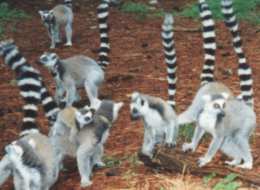
- John
Cleese visits lemurs at San Francisco Zoo - Daily Llama
- 13 Jun 2002: "[Actor John Cleese took]
the first official tour of the Lipman
Family Lemur Forest - a new enclosure that will be the
world's largest outdoor exhibit for this endangered
species." Also reported by the San
Francisco Chronicle.
- Primate
ancestor lived with dinos - BBC
- 17 Apr 2002: "The common ancestor of
humans, monkeys, apes and other primates may have
arisen much earlier than previously thought.
New research suggests the animals from which humans
could have emerged were living in the tree tops 85
million years ago, when the dinosaurs still ruled the
Earth."
- Primate
Center improves conditions, awaits future - The Chronicle
- 18 Jan 2002: "Six months after serious
concerns that it might one day close, the Primate
Center has begun upgrading its facilities and
research, and has added long sought-after bus
service to and from West Campus."
- Madagascar
biodiversity threatened - BBC
- 16 Jan 2002: "Most of the
200,000 plus species of plants and animals found
here are found nowhere else on earth and the island
has been classified as one of the world's top three
'hotspots' for biodiversity."
- Conservation
International lands major grants - CNN
- 9 Dec 2001: "Conservation International
will receive $261 million in grants [from Intel Corp.
co-founder Gordon Moore] in the next 10 years to help
save threatened and unique animal species and
ecosystems around the world, the Washington-based
organization announced Sunday." Also reported by
National
Geographic News.
- Do
Pakistan Fossils Alter Path of Lemur Evolution? -
National Geographic News
- 22 Oct 2001: "The
finding is controversial because the new evidence suggests
that lemurs originated in Asia, not in Africa as commonly
believed."
[A competing theory] "is that the fossil teeth belong to a
family of Eurasian primates-sivaladapis-that are now
extinct."
- Fossils
Suggest Lemurs May Have Asian, Not African, Roots -
Scientific American
- 19 Oct 2001: "It seemed likely that
lemurs originated in continental Africa and later
migrated eastward to the island nation. But new data
suggests that the charismatic creatures could have Asian,
not African, roots. According to a report published
today in the journal Science,
researchers have unearthed the oldest lemur remains
known-tiny teeth some 30 million years old-in Pakistan."
- Lemur
Laments - Duke Alumni Magazine
- Jul-Aug 2001: "Deciding the future of the
Duke Primate Center is certainly an extremely complex,
and even emotional, endeavor. Ambitions must be balanced
with resources, and potentials with realities. But
as excruciatingly difficult and multidimensional as the
decision process is, it represents only one
of many such challenges Duke will face as it heightens
its profile among research universities."
- Primate
Center gets new director - The Chronicle
- 21 Jun 2001: "William Hylander, professor
of biological anthropology, has been given the task of
revitalizing the Primate Center as its new director,
Provost Peter Lange announced Tuesday.
Hylander will succeed Ken Glander, who will step down
July 1 following two reviews of the department
that convinced administrators the center focuses too
heavily on conservationist programs."
- Losing
Lovelorn Lemurs - ABC News
- 31 May 2001: "Romeo is the only member
of his subspecies in captivity, and for the past six
years he has pined away at Duke University's Primate
Center in Durham, N.C., waiting for his Juliet."
- Primate
Center in flux - The Chronicle
- 31 May 2001: "Following months of talk
surrounding the fate of the Primate Center, the University
has decided to devote more resources to the center--at
least in the short term--and will likely not renew the
contract of current director Ken Glander once it expires June
30. The long-term fate of the center remains uncertain."
- Furry
Primates at Risk [lorises] - ABC News
- 9 May 2001: "Not only are these rare primates
good at hiding, they're found in remote rain forests of
Southeast Asia. That's one of the reasons why no one is
sure just how many of these elusive primates are
left in the wild."
- Newly
Discovered Primate in Grave Danger - Wildlife News
- March 2001: "The new lemur species was
discovered while Duke University Primate Center (DUPC)
was on an expedition for the diademed sifaka - a lemur
species represented by only one living lemur outside
Madagascar housed at DUPC in North Carolina. Compared
to diademed sifakas, the lemurs they found were smaller,
had different markings, and much longer canine teeth."
- New
Primates Discovered in Madagascar and Brazil - Environment
News Service
- 26 Jan 2001: "Nine new lemur and two
marmoset species have been discovered in the forests
of Madagascar and Brazil, scientists announced earlier
this month. But the news is not all good - some of the
newly named species may already be endangered, joining
the dozens of other primate species that may face
extinction this century."
- Report:
3 new species of tiny primates discovered - CNN
- 14 Nov 2000: "Three previously unknown species
of mouse lemurs, the world's smallest primates, have been
discovered in Madagascar, scientists announced this week."
Also reported by the BBC.
- Fate
of the Primates - The Chronicle
- 8 Nov 2000: "With the growing jungle of
cutting-edge University initiatives, the lemurs of the Duke
University Primate Center may find greater competition for
survival."
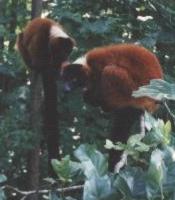
- For
the Love of Lemurs - Audubon Magazine
- Sep/Oct 2000: "As the photo editor for
Audubon, I've seen pictures of just about every
kind of animal. But something about lemurs long ago captured
my fancy. Maybe it's because they don't get the recognition
monkeys and other primates do. Whatever the reason, I knew I
wouldn't be happy until I had seen them in the wild."
- A Fool
for Tarsiers - International Wildlife
- May/June 2000: "Pizarras started keeping
tarsiers more than 30 years ago for his taxidermist father
to stuff and sell. But his increasing fascination with
the strange animals turned him into an observer and protector
of the species."
- It's
a jungle down there - St. Petersburg Times
- 25 Feb 2000: "It's a long way from Madagascar
to Manatee County, but you wouldn't know it from the
sight of the lemurs that make their home in the
relative wilds of Myakka City [Florida]."
- World's
vanishing primates (opinion) - Christian Science Monitor
- 26 Jan 2000: "Primates - apes, monkeys,
lemurs, and their cousins - are our closest living relatives
and have long fascinated us. They've also been regarded as
bellwethers - so-called flagship species - for the
tropical rain forests that shelter them as well as much of our
planet's biodiversity."
- Primates
in Peril - National Geographic
- 12 Jan 2000: "Twenty-five species of apes,
monkeys, lemurs, and other primates are at risk of extinction
within the next two decades, according to a report issued
January 10 by Conservation International and the
IUCN-World Conservation Union (IUCN)."





Last updated 18 Mar 2006

![[Audio]](audio.png) - WCOM-FM
- WCOM-FM







